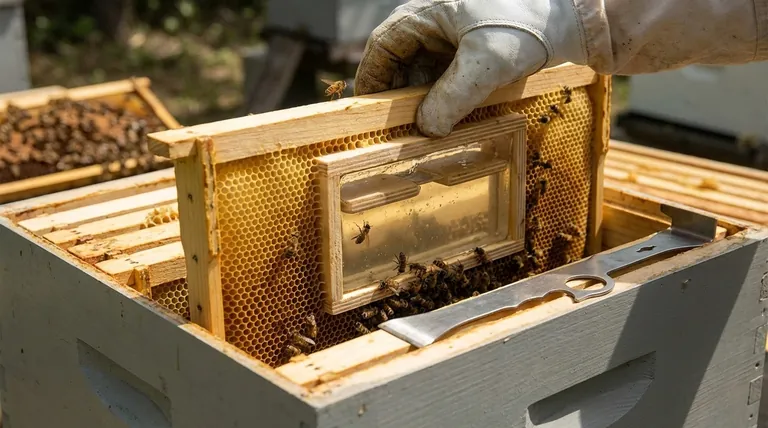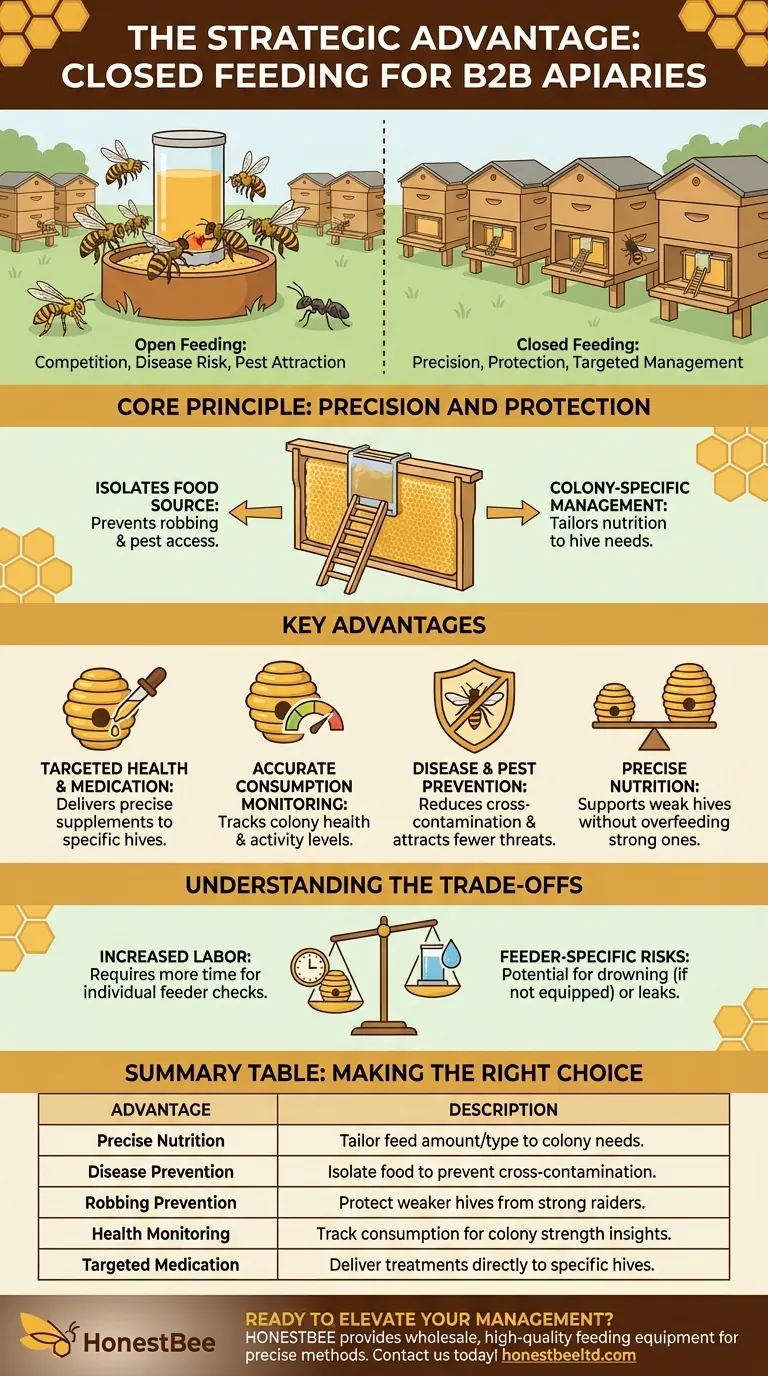When managing bee colonies, the closed feeding method offers significant advantages over open feeding. Its core benefits are providing precise, individual-hive control over nutrition, preventing the spread of disease, and protecting the food source from pests and robber bees. This method transforms feeding from a simple act of providing sugar into a strategic tool for colony management.
The fundamental advantage of closed feeding is not just about what you feed, but how you feed. It allows for targeted, protective, and measurable nutritional support on a hive-by-hive basis, which is impossible with open-air methods.

The Core Principle: Precision and Protection
Closed feeding involves placing a feeder inside the hive or at its immediate entrance. This internal placement is the key to its primary benefits.
Isolating the Food Source
By containing the syrup or pollen patty within a single hive, you eliminate competition. This prevents "robbing," a behavior where stronger colonies raid weaker ones for their food stores, which can decimate a struggling hive.
It also keeps the food away from pests like wasps and ants, as well as larger animals, ensuring the intended colony is the only one to benefit.
Colony-Specific Management
No two colonies are identical. A young nucleus colony has vastly different nutritional needs than a large, established production hive.
Closed feeding allows you to tailor the amount and type of feed for each specific colony. You can give a weak hive extra support to build up its population without over-feeding a strong one.
Targeted Health and Medication Delivery
This is perhaps the most critical advantage for proactive beekeepers. If a hive shows signs of stress or illness, you can add specific supplements, medications, or essential oils to its individual feeder.
This ensures the correct dose is delivered only to the colony that needs it. In open feeding, any additives are shared indiscriminately across all bees in the area, including those from other apiaries.
Accurate Consumption Monitoring
A closed feeder acts as a gauge for colony health and activity. You can accurately measure how much food a hive consumes over a set period.
A strong, growing colony with a laying queen will rapidly consume syrup. A sudden drop in consumption can be an early warning sign of a problem, such as a queenless state, disease, or a pending swarm, prompting you to inspect the hive.
Understanding the Trade-offs
While highly effective, the closed method is not without its considerations. Objectivity requires acknowledging the downsides compared to open feeding.
Increased Labor and Disturbance
Managing closed feeders is more labor-intensive. You must visit and open each individual hive to check levels and refill the feeders, which takes more time than filling one large, central open feeder.
Each time you open the hive, you also cause a minor disturbance to the colony, breaking the propolis seal and temporarily disrupting their work.
Feeder-Specific Risks
Different types of internal feeders come with their own challenges. Frame feeders and some top feeders can pose a risk of bees drowning in the syrup if not equipped with proper floats or ladders.
Leaks from an internal feeder can also be problematic, potentially spilling syrup inside the hive, which can stress the bees and attract pests if it runs out the entrance.
Making the Right Choice for Your Goal
Your choice of feeding method should align directly with your beekeeping objectives.
- If your primary focus is targeted health management: Closed feeding is the only effective method for delivering precise nutritional or medicinal support to individual colonies.
- If your primary focus is preventing robbing and resource competition: The internal nature of closed feeding offers unmatched protection for weak hives and ensures your investment in feed goes where it's intended.
- If your primary focus is monitoring colony strength: Tracking consumption rates with a closed feeder provides invaluable data on a hive's growth, health, and queen status.
Ultimately, choosing the closed feeding method empowers you to move from being a bee-haver to a proactive and strategic beekeeper.
Summary Table:
| Advantage | Description |
|---|---|
| Precise Nutrition | Tailor feed amount and type to each colony's specific needs. |
| Disease Prevention | Isolate food source to prevent cross-contamination between hives. |
| Robbing Prevention | Protect weaker hives from being raided by stronger colonies. |
| Health Monitoring | Track consumption rates as an indicator of colony strength and queen status. |
| Targeted Medication | Deliver supplements or treatments directly to specific hives. |
Ready to elevate your apiary management with the strategic advantages of closed feeding? HONESTBEE supplies commercial apiaries and beekeeping equipment distributors with the high-quality, wholesale-focused feeding equipment needed to implement this precise method effectively. Our durable internal feeders are designed to minimize drowning risks and leaks, helping you protect your investment and ensure colony health. Contact our expert team today to discuss your wholesale needs and build a more resilient, productive operation.
Visual Guide

Related Products
- HONESTBEE Advanced Ergonomic Stainless Steel Hive Tool for Beekeeping
- Professional Dual-End Stainless Steel Hive Tool for Beekeeping
- Professional 3-Bar Frame Grip with Integrated Hive Tool
- Yellow Plastic Bucket Pail Perch for Beekeeping
- Beehive Handle and Frame Rest Cutting Machine: Your Specialized Hive Machine
People Also Ask
- Why do hive tools have a hole? Unlock the Secret to Efficient Beekeeping
- What is a hive tool and what are its uses? Master Your Hive Inspections with the Essential Beekeeper's Tool
- How should beekeepers handle bees when using a hive tool? Master Calm, Deliberate Techniques
- What are the basic tools for beekeeping? Essential Starter Kit for Safe & Successful Hive Management
- What are the features of a regular hive tool? The Essential Multi-Tool for Every Beekeeper



















